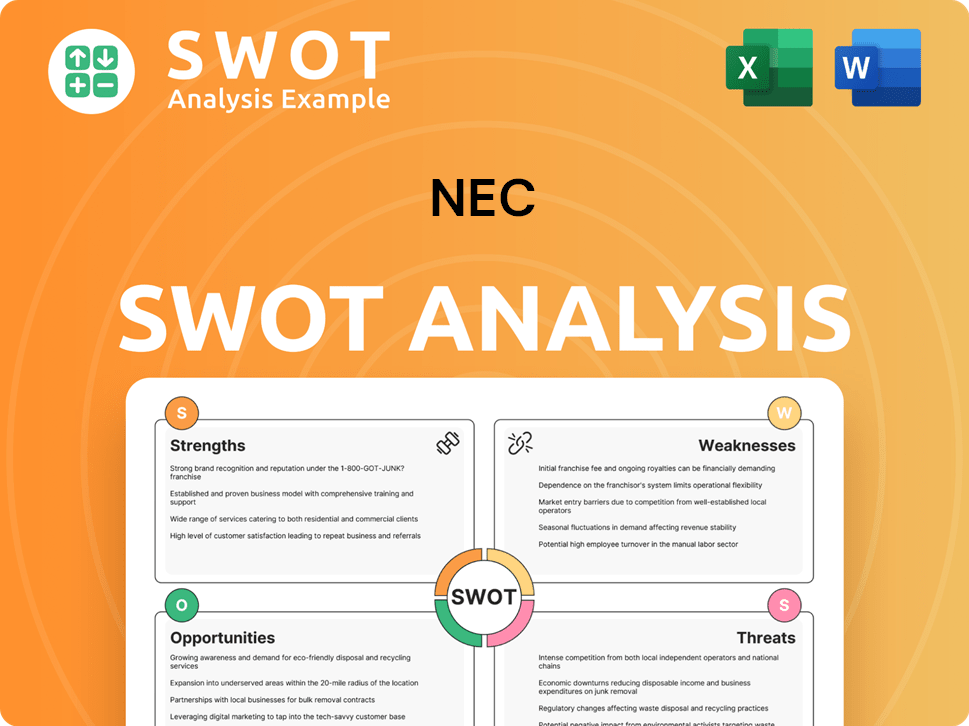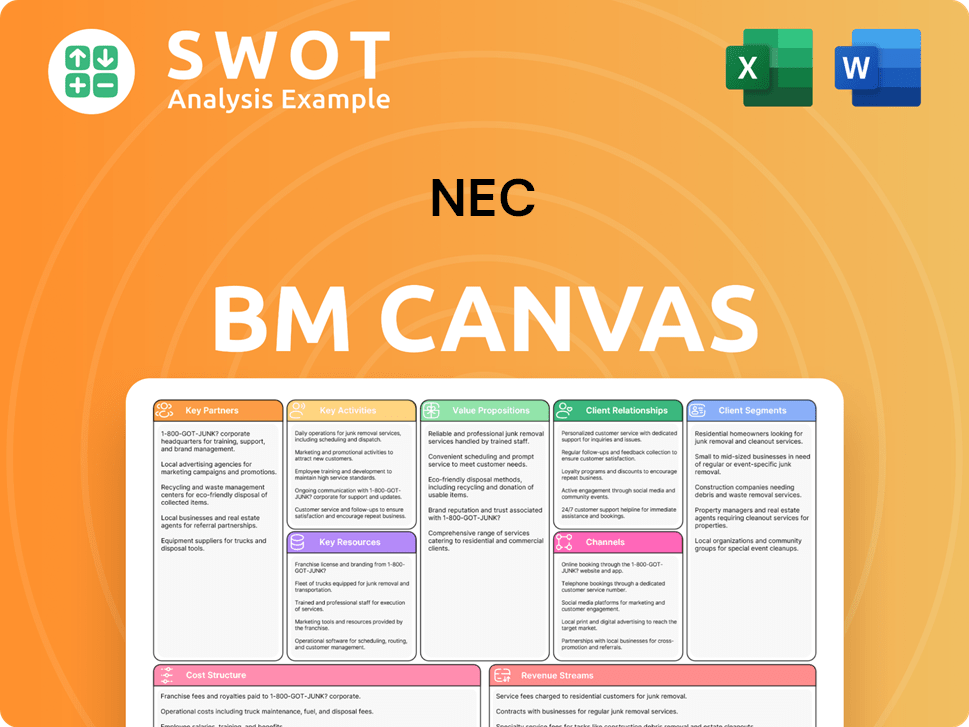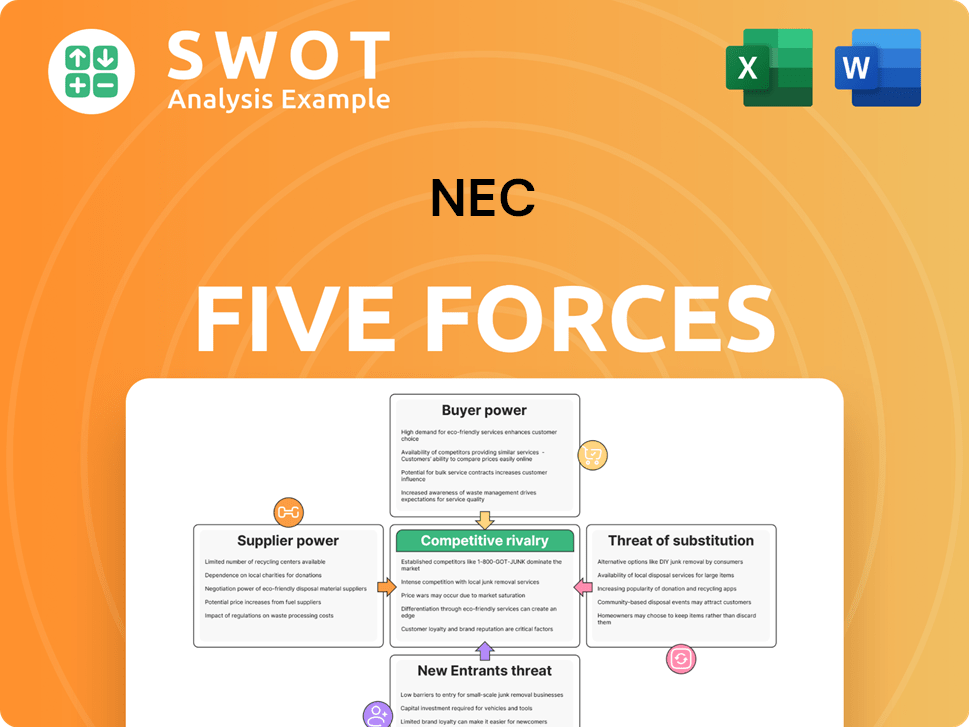NEC Bundle
Who Buys from NEC? Unveiling the Tech Giant's Customer Base
Understanding the intricacies of customer demographics and target markets is critical for any company's success, and for NEC Corporation, a global technology leader, this understanding has been crucial throughout its extensive history. Founded in 1899 in Japan, NEC has consistently adapted to technological advancements and demographic shifts. This introduction sets the stage for a deeper exploration into who NEC's customers are, where they reside, and what their evolving demands entail.

NEC's NEC SWOT Analysis provides valuable insights into its strategic positioning within its target market. As NEC continues its journey, understanding its customer demographics and NEC target market is essential. This analysis will delve into NEC's customer base, market segmentation, and business strategy to reveal how NEC identifies its customer demographics and caters to its diverse clientele, from telecommunications to cutting-edge IT solutions. This exploration provides a comprehensive NEC company profile.
Who Are NEC’s Main Customers?
Understanding the customer demographics and target market of NEC Corporation reveals a focus on institutional clients. NEC primarily operates in the business-to-business (B2B) and business-to-government (B2G) sectors, serving large organizations with IT and network solutions. The company's strategic direction, as outlined in its Mid-term Management Plan 2025, underscores its commitment to these key segments.
The NEC customer base is diverse, spanning telecommunications carriers, government agencies, and enterprises across various industries. These clients seek solutions to optimize operations, enhance security, and drive digital transformation. NEC's approach is tailored to meet the specific needs of these sectors, offering robust and scalable IT infrastructure, including cloud computing, AI, IoT, and cybersecurity solutions. For a deeper dive into the company's origins and evolution, consider reading the Brief History of NEC.
The company's focus on digital transformation is evident in its investment in growth areas like Digital Government/Digital Finance and global 5G. This strategic pivot is driven by market trends and the increasing demand for advanced digital solutions. NEC's revenue reached JPY 3,423.4 billion for the fiscal year ending March 2025, with the domestic IT services sector showing strong performance, increasing revenue by 12% year-on-year. Furthermore, NEC achieved its goal of employing 10,000 DX personnel by fiscal year 2025.
NEC's B2B customers are typically large enterprises across sectors like healthcare, finance, manufacturing, and transportation. These organizations require advanced IT infrastructure to improve efficiency and security. They often seek solutions for cloud computing, AI, and cybersecurity.
Government agencies form a significant part of NEC's target market, particularly in digital government initiatives. These clients focus on efficiency, public safety, and citizen engagement. NEC provides integrated ICT solutions to meet these needs, including smart city solutions.
NEC's customer segmentation strategy emphasizes growth areas like Digital Government/Digital Finance, global 5G, and core DX. The company aims to improve profitability in foundational businesses while expanding in high-growth markets. This strategic shift is supported by significant investments and a focus on digital transformation.
- Telecommunications Carriers: Providing network infrastructure and solutions.
- Government Agencies: Offering digital government and smart city solutions.
- Enterprises: Delivering IT solutions across various sectors like healthcare and finance.
- Focus on Digital Transformation: Targeting clients undergoing significant technological shifts.
NEC SWOT Analysis
- Complete SWOT Breakdown
- Fully Customizable
- Editable in Excel & Word
- Professional Formatting
- Investor-Ready Format

What Do NEC’s Customers Want?
Understanding the customer needs and preferences is crucial for the success of any business. For NEC, this involves a deep dive into the requirements of its primary customers, which include businesses and governments. The company focuses on providing solutions that enhance operational efficiency, ensure robust security, and facilitate digital transformation.
The purchasing decisions of NEC's customers are significantly influenced by the reliability and scalability of the solutions offered. Integration capabilities with existing infrastructure and the long-term value proposition are also key considerations. NEC prioritizes addressing specific pain points, such as optimizing complex processes, safeguarding sensitive data, and improving public services. This customer-centric approach is central to NEC's business strategy.
NEC's commitment to understanding its customer base is evident in its investments in research and development. This proactive approach allows the company to stay ahead of technological advancements and meet the evolving demands of its customers. For example, NEC's focus on specialized AI models for various industries, including healthcare, finance, and manufacturing, directly responds to the unique operational transformation needs of these sectors.
Customers in the smart cities sector seek integrated command and control centers, citizen engagement portals, and intelligent video analytics. NEC's solutions aim to enhance urban management and citizen engagement. These technologies are designed to improve the quality of life and promote sustainable development.
NEC is developing a generative AI marketing strategy tool, slated for release in 2024, to better identify customer interests. This tool uses AI insights and consumer data to create tailored strategies and predict marketing effectiveness, increasing success rates.
Customers are often driven by a desire for innovation and trust in a long-standing technology leader. The assurance of a secure and reliable partner for critical infrastructure is also a key factor. These psychological drivers influence the choice of NEC's offerings.
Practical drivers include the need for cutting-edge technologies like AI, IoT, and cloud computing to stay competitive. These technologies are essential for operational efficiency and are a focus for NEC's offerings. This helps NEC define its target market.
Government clients may be driven by the vision of creating 'smart cities' that offer a higher quality of life and sustainable development. This aspirational goal aligns with NEC's mission to provide innovative solutions. NEC's marketing strategies target this audience.
Customer feedback and market trends significantly influence NEC's product development. The company leverages data analytics and customer feedback to anticipate needs and deliver solutions that exceed expectations. This is a core part of NEC's customer segmentation analysis.
The NEC target market is diverse, encompassing various sectors that require advanced technological solutions. NEC's approach to understanding its target market involves continuous analysis and adaptation to meet evolving customer needs. For more insights into NEC's financial performance and business model, consider reading Revenue Streams & Business Model of NEC.
NEC's focus on customer needs is driven by the desire to provide innovative and reliable solutions. The company's approach involves understanding the specific requirements of each sector and tailoring its offerings accordingly. This helps in identifying NEC's customer base.
- Operational Efficiency: Customers seek solutions to streamline processes and reduce costs.
- Security: Robust security measures are essential to protect sensitive data and critical infrastructure.
- Digital Transformation: Clients require technologies that enable them to modernize their operations and stay competitive.
- Scalability: Solutions must be able to adapt to changing needs and grow with the business.
- Integration: Seamless integration with existing systems is crucial for minimizing disruption.
NEC PESTLE Analysis
- Covers All 6 PESTLE Categories
- No Research Needed – Save Hours of Work
- Built by Experts, Trusted by Consultants
- Instant Download, Ready to Use
- 100% Editable, Fully Customizable

Where does NEC operate?
The geographical market presence of NEC Corporation is a crucial aspect of its business strategy, influencing its customer demographics and overall success. NEC has a significant global footprint, with operations and customer bases strategically located across key regions. This global reach allows NEC to cater to a diverse range of clients and adapt its offerings to meet specific regional demands.
NEC's approach to its NEC target market involves tailoring its products and services to the unique needs of each region. This localized strategy is essential for effectively serving its NEC customer base and maintaining a competitive edge. By understanding the nuances of each market, NEC can optimize its market segmentation and enhance its business strategy.
NEC's market presence is not static; it evolves based on market dynamics and strategic priorities. Recent developments, such as acquisitions and partnerships, reflect NEC's commitment to adapting its geographical focus to maximize growth and profitability. These adjustments are vital for ensuring NEC remains competitive and responsive to changing market conditions.
Japan, as NEC's home market, remains a primary focus. The company's IT services and social infrastructure solutions are heavily concentrated here. Domestic IT services saw a 12% year-on-year revenue increase for the fiscal year ending March 2025.
NEC is expanding its presence in the Asia-Pacific region, particularly in digital government and wealth management solutions. The launch of the Global Smart City Suite in India in February 2024 is a key example of this expansion, introducing solutions for urban management and citizen engagement. This region is a key area for growth.
NEC has a significant presence in Europe, especially in digitally advanced countries. The company focuses on IT services and government digitalization expertise in countries like the United Kingdom and Denmark. Strategic partnerships and acquisitions have been key to this expansion.
The Americas, including the U.S., Canada, and Latin America, have seen strategic shifts. For example, the on-premise Unified Communications business was acquired by Forerunner Technologies in February 2025. However, NEC Japan continues to support these platforms through 2030.
NEC's approach to understanding its customer demographics involves tailoring its offerings to regional needs. This includes adapting software and expertise, such as rolling out solutions from European acquisitions to the Asia-Pacific region and Japan. Furthermore, NEC adapts its marketing and partnerships to succeed in diverse markets, leveraging local sales channels and collaborating with regional partners. For more insights, consider reading about the Growth Strategy of NEC.
NEC localizes its offerings by tailoring software and expertise to specific regional needs. This approach ensures that products and services meet the unique requirements of each market segment. This is a key element of NEC's NEC customer segmentation analysis.
Recent expansions and strategic withdrawals reflect NEC's dynamic market entry and exit strategies. For example, the company is expanding its AI-based agricultural support solutions through strategic partnerships. This shows how NEC's business strategy evolves.
In the telecom services business, NEC is prioritizing profitability by reducing upfront costs for overseas expansion. This strategic shift is influenced by 5G investment falling short of initial expectations. This demonstrates NEC's focus on optimizing geographic distribution of sales and growth.
NEC adapts its strategies based on market realities and profitability goals. This includes adjusting investments and focusing on areas with higher growth potential. This approach helps NEC to effectively manage its NEC market segmentation.
NEC is actively expanding its AI-based agricultural support solutions through strategic partnerships. This move highlights the company's focus on innovation and leveraging new technologies for growth. This is part of NEC's company profile.
In the telecom services business, NEC has shifted its operations to prioritize profitability. This includes reducing upfront costs for overseas expansion. This strategic change reflects NEC's ability to adapt to market conditions.
NEC Business Model Canvas
- Complete 9-Block Business Model Canvas
- Effortlessly Communicate Your Business Strategy
- Investor-Ready BMC Format
- 100% Editable and Customizable
- Clear and Structured Layout

How Does NEC Win & Keep Customers?
Understanding and effectively engaging with its customer demographics and target market is crucial for NEC's success. The company's strategies are meticulously designed to attract and retain clients, particularly within the B2B and government sectors. These strategies are deeply rooted in technological innovation, relationship building, and providing customized solutions to meet specific customer needs.
NEC employs a multi-faceted approach for customer acquisition and retention, focusing on digital and traditional marketing channels, strategic partnerships, and personalized experiences. This comprehensive strategy is supported by advanced CRM systems and a strong emphasis on innovation, including significant investments in research and development. NEC's commitment to adapting its strategies, as reflected in its Mid-term Management Plan 2025, underscores its dedication to long-term customer value and sustained profitability.
The company's success in its NEC target market also hinges on its ability to adapt and innovate. By focusing on customer needs and preferences, NEC aims to build lasting relationships and drive growth in a competitive market. This approach is evident in its strategic partnerships and the development of cutting-edge technologies, like generative AI, to meet evolving market demands.
NEC utilizes a mix of digital and traditional marketing channels. Digital marketing includes showcasing its advanced AI and global network technologies at major events like MWC Barcelona 2024, highlighting its generative AI applications and real-world use cases. This approach helps in reaching a broad audience.
Direct sales engagement and strategic partnerships are central to NEC's sales tactics. They form alliances with industry leaders and technology providers to enhance product offerings and expand market reach. For example, the collaboration for the NEC generative AI advanced customer program.
NEC focuses on understanding unique customer needs and preferences to tailor products and services. Their customer engagement strategy focuses on creating personalized experiences, leveraging data analytics and customer feedback to anticipate needs. This is crucial for NEC customer base.
NEC utilizes CRM strategies to manage customer interactions across various touchpoints, tracking interactions, analyzing data, and providing personalized recommendations. The development of a generative AI marketing strategy tool in 2024 underscores their commitment to using AI and consumer data.
NEC's approach to NEC market segmentation and customer acquisition is also influenced by its strategic initiatives and a focus on innovation. The company is investing heavily in research and development, particularly in generative AI, to develop cutting-edge products and services. This commitment to technological advancement is designed to meet evolving customer needs and maintain a competitive edge. The company's Mid-term Management Plan 2025 reflects a strategic shift towards accelerating global growth, emphasizing customer value through technology and strategic mergers and acquisitions.
Investment in research and development is a key driver for customer acquisition. NEC is developing cutting-edge products and services that meet evolving needs. Their focus on generative AI aims to achieve significant sales over the next three years.
NEC's Mid-term Management Plan 2025 reflects a strategic shift towards accelerating global growth. This includes a focus on maximizing long-term profit and optimizing short-term profit. The company aims to improve profitability by focusing on software businesses and shifting to a SaaS model.
NEC forms alliances with industry leaders and technology providers to enhance product offerings and expand market reach. This is evident in their collaboration with companies and universities for the NEC generative AI advanced customer program. These alliances are important for NEC's business strategy.
NEC uses CRM strategies to manage customer interactions across various touchpoints. This includes tracking interactions, analyzing data, and providing personalized recommendations. This approach enables NEC to understand and respond to customer needs effectively.
NEC is heavily investing in generative AI, with a lightweight large language model launched in spring 2024 and a larger model with 100 billion parameters under development. The company aims to achieve sales of approximately 50 billion yen over the next three years from this business.
The acquisition of NEC's on-premise Unified Communications business by Forerunner Technologies in February 2025, with NEC Japan committing to continued software assurance and licensing through 2030, highlights their dedication to long-term support and service.
To understand NEC's position, it is crucial to also consider the competitive landscape. For a detailed analysis of NEC's main competitors, read this article: Competitors Landscape of NEC. Understanding the competitive environment helps NEC refine its strategies.
- NEC's focus on B2B and government sectors requires a deep understanding of their specific needs.
- Strategic partnerships and direct sales efforts are essential for reaching and serving these key customer groups.
- Innovation in areas like generative AI and commitment to long-term customer support are vital for retaining customers.
- The company's Mid-term Management Plan 2025 highlights its focus on global growth and customer value.
NEC Porter's Five Forces Analysis
- Covers All 5 Competitive Forces in Detail
- Structured for Consultants, Students, and Founders
- 100% Editable in Microsoft Word & Excel
- Instant Digital Download – Use Immediately
- Compatible with Mac & PC – Fully Unlocked

Related Blogs
Disclaimer
All information, articles, and product details provided on this website are for general informational and educational purposes only. We do not claim any ownership over, nor do we intend to infringe upon, any trademarks, copyrights, logos, brand names, or other intellectual property mentioned or depicted on this site. Such intellectual property remains the property of its respective owners, and any references here are made solely for identification or informational purposes, without implying any affiliation, endorsement, or partnership.
We make no representations or warranties, express or implied, regarding the accuracy, completeness, or suitability of any content or products presented. Nothing on this website should be construed as legal, tax, investment, financial, medical, or other professional advice. In addition, no part of this site—including articles or product references—constitutes a solicitation, recommendation, endorsement, advertisement, or offer to buy or sell any securities, franchises, or other financial instruments, particularly in jurisdictions where such activity would be unlawful.
All content is of a general nature and may not address the specific circumstances of any individual or entity. It is not a substitute for professional advice or services. Any actions you take based on the information provided here are strictly at your own risk. You accept full responsibility for any decisions or outcomes arising from your use of this website and agree to release us from any liability in connection with your use of, or reliance upon, the content or products found herein.